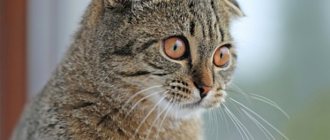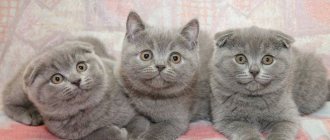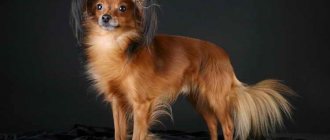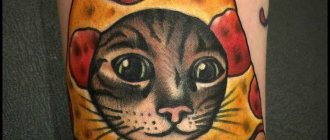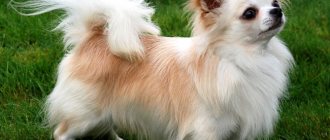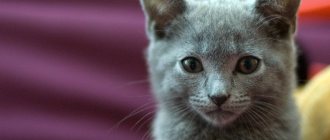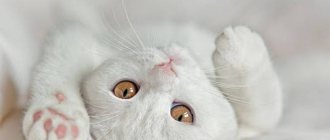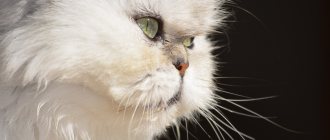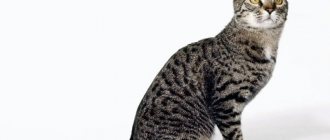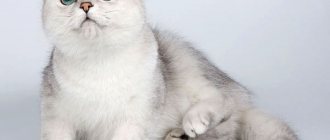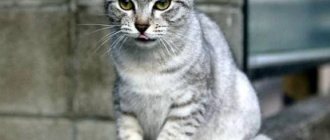A high-quality long-haired Scottish cat should have a spherical head (with fur, of course, it looks a little different), a round forehead, smoothly turning into a short, wide nose without a hump. The muzzle is round due to well-developed cheekbones and jaw, rounded, filled whisker pads.
Body
The body of the Highland Straight is quite slender, but strong and muscular. Weight - 3.5-4 kg for cats and 4-6 kg for cats. Height - approximately 30 cm.
Movements should be free, not painful, and the hind legs should allow for good jumping. The tail is long (to the middle of the shoulder blade), mobile, moderately wide.
Ears
Highland straights have special ears. They should be modest in size, erect, with rounded tips and can be decorated with beautiful long wool tassels. Other ears, such as those that are too large, are a defect that may result in a lower grade at the show.
History of the breed
The Highland Straight breed gained recognition only at the end of the last century, although there are plenty of people who want to have a straight-eared Scottish. These cute creatures are a constant success at cat shows.
Highland Straight
The ancestors of modern individuals were wild cats living in the mountains of Scotland. Crossing them with a Persian cat, then with a British one, made it possible to obtain enormous diversity within the breed.
Other and obsolete names of the breed
The breed includes varieties with hanging ears - Scottish Folds, Highland Folds and with erect ears - Scottish Straights and Highland Straights. They differ:
- the structure of the ears;
- coloring;
- length of wool.
Psychology
The Scottish Highland Straight has a good-natured and balanced character. These cats are very smart, neat and attached to their owner. They are peaceful and love being in the company of people, and they are also easy to train.
Highland Straights are peaceful and intelligent cats
Highland Straight kittens, like Maine Coons and British babies, are very playful, they can frolic for a long time both with the owner and with each other. Adults are characterized by independence; they themselves are not so persistent in drawing attention to themselves. Cats are calm, graceful and very charming.
Appearance
Like any other breed, the Highland Straight has its own standards. Compliance with them is especially important for exhibition specimens.
Highland Straight: description of the breed (WCF standard)
Highland fold (Scottish fold longhair cat)
The Scottish Longhair cat has a dense, rounded body. Due to the short paws, there is some stockiness.
The animal's head is large and round. Very beautiful large, round eyes, plump cheeks. The profile is soft, with a neat round chin. The cat's ears are small, pointed at the top and wide at the base. The tail is fluffy, mobile, and short.
The weight of males reaches 5 kg, and that of females - up to 3.5 kg. Cats are distinguished by the presence of a fluffy “collar”.
Interesting! The color of animals can be completely different. It is noteworthy that the color of the iris matches the color of the coat.
Application
The Highland Straight kitten is an ideal pet for home keeping and a great friend.
Since this variety is a separate breed, it has certain standards for participation in exhibitions.
If a kitten has such features as ears that are too large or reclining, it is classified as PET class.
This cat does not participate in exhibitions, but will become a wonderful friend and pet.
Eye color depends on coat color
Character and behavior
The Scottish Straight Longhair cat is an ideal pet for pets. There are no problems with potty training or scratching posts.
Scottish Straight (Scottish Straight cat)
Friendly and inquisitive animals can easily occupy themselves with independent play, but they immediately respond to the call of their owner. Although playfulness ends with growing up. Adults prefer a soft chair. They can lie around the clock, distracted only by feeding and taking care of natural needs.
Scots Longhairs have a very good memory. Insults do not go unanswered. By scolding and using force, you can forever lose trust on their part. They also cannot stand noise and screams - they try to move away and hide.
Relationship with the owner
The animal chooses one owner and treats the rest of the family with respect. It is very hard for him to part with his owner, but he soon switches to someone else.
The Scottish Straight and long-haired cat is very attached to its home. Any change of environment is stressful for her.
Interesting! Highlands come to their owner for affection only voluntarily. It is impossible to force them to lie on your lap or next to you in bed.
Relationship with other pets
There are no problems with other pets. If a cat starts hunting, it will be some kind of flying insect. Only nursing mother cats can show aggression.
Highland straight character
Highland Straights are intelligent and inquisitive cats. They are very friendly towards their family. As a rule, these cats do not hide around the house and are not shy - on the contrary, they always follow their household members from room to room like a tail.
This breed is called four on the floor kitties by breeders and show judges (translated from English as “a cat with all four paws standing on the ground”). That is, Highlands will always be next to you, but at the same time they will “stand firmly on the floor” - they do not like being picked up too much, depriving them of reliable support. They also do not like idleness - they are always busy with something.
Highland Straights are smart and curious cats
The intelligence and curiosity of the Highland allows them to learn things like opening doors to look inside, turning lights on and off to understand how this strange process works. Some Highlands can be trained to fetch and fetch.
Many pets love to drink running water, which is why they learn to open the taps. A few more funny features of the breed - they often drink and eat with the help of their paws, take the pose of hunting dogs when they hear unusual sounds, and look around carefully. But the cutest habit of all cats of the Scottish group is to take the “Buddha pose”, that is, sit down in human style and rest like that for hours.
This is a rather imposing and quiet breed. They are affectionate and kind, and get along well with other animals if they came into the house before the Highland Straight. If you are planning to bring another animal into a house where there is a Highland, then you need to introduce them carefully so that the cat does not get jealous. However, for those whom the Highland has accepted into his “pack”, he will become the most affectionate and devoted comrade. This active and at the same time patient breed is perfect for children of any age and large families. The main thing is not to pick up the cat too often, so that it doesn’t get scared and accidentally hurt itself and the baby.
Video: features of the long-haired straight-eared breed
Features of care
British longhair cat, fluffy British cat
Like all cats, Scottish Longhairs are extremely clean cats. They can lick their fur for hours. Given the long and thick hair, the owner should help the pet keep its coat in good condition.
Long-haired cats need special coat care
The same applies to keeping your cat's litter box clean. She will not go into a dirty one; she will rather find a suitable place for herself (but not for her owners!) outside the potty.
Additionally, you should clean your pet's eyes and ears.
Grooming
It is advisable to brush your cat daily. At the very least, you should run a wet palm over the skin. If you do this often enough, you can get by with weekly brushing.
Important! Under no circumstances should tangles be allowed to form.
Washing Highland Straight
Representatives of the breed, despite their long hair, do not need frequent washing. Usually three times a year is enough. For bathing, you need to use a special shampoo and rinse off very well after the procedure. The balm will help add volume and silkiness to the coat.
Important! It is absolutely forbidden to use human cleaning products.
If the animal is not very afraid, then you can dry the wool with a hairdryer.
Combing
You can use various combs to brush your cat. It could be:
- brush with rounded metal teeth;
- slicker;
- mitten with spiked teeth;
- furminator;
- comb;
- massage brush made of natural bristles.
Walk
Representatives of the breed are small lovers of walking. There is no need to force them outside. Walking on the balcony is quite enough for them. If you come across a traveler specimen, you will need to buy a harness at the store and take it with you to parks or green alleys.
Castration and sterilization
If the owner does not plan to engage in breeding, he should decide in advance to sterilize or castrate the animal. It is advisable to carry out such operations at the age of 10–12 months. Castration implies complete removal of the genital organs, and sterilization only deprives the ability to reproduce, but does not eliminate the need to mate. The first option is much more humane, since the animal does not suffer from the lack of a partner and completely loses interest in the opposite sex.
After surgery, cats recover within 4-5 days, cats - about 2 weeks. During the rehabilitation period, it is better to move the pet’s bed to the floor, place bowls of food and water nearby so that the animal does not have to walk and jump a lot. Wounds should be treated with brilliant green. To prevent the seams from coming apart, you need to put a special blanket on your cat.
Some owners give their pets special drugs that suppress sexual desire, believing that this method is more humane than castration or sterilization. I strongly do not recommend adopting their experience. Veterinarians have proven that frequent use of tablets or hormonal drops leads to metabolic disorders and serious health problems. In addition, this method does not solve the problems: cats still leave smelly marks, and cats become lethargic and irritable.
Feeding
Highland Straights are not picky eaters, but it is easiest to keep them on premium dry food. They are balanced, that is, they contain everything you need.
If natural nutrition is meant, then the menu should include:
- dietary meat (beef, rabbit, chicken, turkey);
- cereals (buckwheat, rice);
- kefir (ryazhenka, yogurt);
- greenery;
- vegetables;
- vitamin supplements.
Food from the table is strictly not recommended. The meat should be scalded with boiling water before serving. And under no circumstances should you give cow's milk.
Interesting! These pets never beg for food.
They will wait patiently until the owner takes care of them.
Relationship with the owner
A distinctive feature of Scottish Highland Straights is their ability to adapt to the mood of their owners, just like their fold-eared relatives. Despite its sociability, a cat will never impose its company. Another interesting trait is patience and endurance. A Highland Straight cat will calmly wait until the owner finishes his business and fills her bowl with food or simply pets her. These are very gentle animals that do not show aggression. At the same time, they are extremely vulnerable and touchy. The cat will simply ignore an owner who goes too far in his upbringing.
Wonderful longhaired Scotsman
Important! With a Highland Straight cat, the owner needs to be gentle and patient.
Health status
Scots are born in good health. No genetic abnormalities in development were found. If the maintenance rules are followed, Scottish representatives live 12-20 years.
The color of the eyes and fur of cats can be different.
Tendency to diseases
Due to their lack of mobility, Highlands easily gain excess weight and this can lead to problems with the spine and musculoskeletal system.
In order to maintain the health of your pet, it is imperative to vaccinate it, doing this annually. There are two mandatory types of vaccines.
Antiviral and anti-infective against such diseases:
- rhinotracheitis;
- panleukopenia;
- calicivirus;
- chlamydia;
- rabies.
If there are other pets living in the house, it would be a good idea to add vaccinations against:
- ringworm;
- coronavirus;
- viral leukemia;
- infectious peritonitis.
Important! Half a month before vaccination, the animal must be treated for worms.
The start of vaccinations depends on the kittens' lifestyle. If they are nursed by their mother, antibodies protect them through milk. Artificial or weaned kittens should begin to be vaccinated at 2.5 months of age.
Nutrition
There are two options for feeding a Highland Straight cat: professional food; food prepared by the owners, but here you need to carefully consider the diet, give special supplements and vitamins. The first option is preferable - it is better to use a diet for elite breeds. Such a balanced menu will maintain your pet’s health and provide its body with all the necessary substances. There are quite a few super-premium cat foods out there. These are brands such as Almo Nature diet, Bozita, Grandorf, Brit.
Breeding
The Highland Straight can be mated with any representatives of the Scots species. It can be:
- similar specimens (but not closely related);
- fold (fold) with short/long hair.
At one time, a mother cat can give birth to 5-6 cubs. What ears will be like will become clear by 1.5-2 months. The mating of a short-haired individual with a long-haired one implies the birth of babies with different hair lengths.
Mated cats can be used from 10 months, and cats from 1.5 years. The meeting of animals takes place on the territory of the seal and lasts 2-3 days.
We must remember! Before mating, both partners must undergo the necessary vaccinations and deworming.
A cat gives birth after about 65 days. The onset of labor can be understood by behavior. She begins to look for a secluded place - prepares a nest.
Pregnancy and childbirth in representatives of the breed usually occur without complications. Kittens are looked after by both parents (if any). They are very responsible and caring parents. They will teach you everything they know.
Varieties
Highland Fold Fold. In appearance, these pets may look very large, but in fact they simply have too fluffy fur and a large bone. Therefore, these pets are not obese or overweight. Cats of this breed have the following characteristics.
- The head is round, medium in size, with a chin, cheeks and jaw located on it.
- The body is short and proportional to the head. The paws are small, round in shape, and look too furry. The weight of an adult pet can reach 7-8.5 kilograms.
- A cat has a distinctive feature - its ears. They are always folded. The ears have single, double, sometimes triple folds that determine their shape. When kittens reach the age of 3 weeks, their folds are already visible. Ears are the main characteristic that determines the thoroughbred of a pet.
- The eyes are set wide and large. They are round in shape, so they fit well with the roundness of the pet. The shade of the eyes matches the shade of the fur. All parts of the face give the cat a surprised expression.
- The cat's fur is very soft, light and silky to the touch. The hind legs and chest have longer fur.
The color of the coat can be varied, but it will not have white spots and it will not have lilac and chocolate undertones. There is such a color as color point - the pet’s body color has light tones, and the paws, tail and muzzle have dark shades.
The color of a cat's fur can be solid, striped, or spotted. The rarest thing you can come across is a marble shade. The most popular are tortoiseshell, gray, smoky, white and black coat tones. There are representatives of the breed that have colors such as bicolor and tabby.
The rarest coloring is “turtle in patches”. This color can only be found in females. It appears thanks to a combination of tortoiseshell and bicolor. In this case, the animal’s body will have 3 colors. The lower part of the body will have a light shade, and the upper part will have a tortoiseshell tone.
The straight-eared, fluffy Highland Straight is a rare breed, so such cats can only be seen at exhibitions and in special nurseries. These animals have close relatives - Persian and British cats. Thanks to this, the animal has fur of a rare color. The distant ancestor of these breeds is the wild cat, which lived in the 18th century in the mountains of Scotland.
This breed is usually bred by crossing a Highland Straight with a Highland Fold. If you use a female and a male from the same breed, a genetic pathology may develop. Crossbreeding may result in kittens that have both erect and drooping ears.
The long-haired cat has a massive but small body. Its weight varies from 4 to 6 kg. The head has a round appearance, the plump cheeks protrude slightly. The forehead is wide, has a small notch near the nose. Animals' eyes are set wide apart. The fur is long, silky, and has many color options, each of which can match the eyes.
The ears are medium in size, with rounded ends. The pet has thick paws, so it appears plump. But the body itself is not thick, it has average dimensions.
How to choose a kitten
It is very important to buy a kitten from a specialized nursery. There, the likelihood of buying a sick animal is minimized. By three months, kittens are vaccinated against all possible diseases, potty trained and switched to special food.
The appearance of kittens must correspond to the standard
If you plan to purchase a pet from your own hands, then you need to pay attention to the following factors:
- appearance;
- behavior;
- availability of a vaccination certificate.
A healthy kitten's mouth should smell of nothing but milk. Dull fur, a large belly, discharge from the eyes, nose and ears, and a non-flexible tail should alert you.
The gender of the kitten matters only depending on the purpose of the acquisition. If you exclude breeding, both male and female cats are suitable. They are no different in character. For breeding, cats are easier to handle. Pregnancy and feeding the offspring somewhat changes the order of keeping a cat. Additional knowledge will be needed here.
Where can I buy a kitten
You can buy a kitten in nurseries or by hand. You can find the necessary information on notice boards. When purchasing at a nursery, the price will depend on the purpose of the purchase and ranges from 10 to 70 thousand rubles. Private owners may offer a lower price.
Combing
The Highland Straight belongs to the long-haired representatives of the cat family. Therefore, the animal’s luxurious fur coat requires appropriate attention and care.
The basic set of cosmetic tools includes: a comb with long teeth, a brush with natural bristles, and a special furminator. Straights need to be combed at least once a week. But during the molting period you will have to switch to daily care.
A careless attitude towards your pet's fur will lead to constant problems with fur scattered throughout the apartment.
In addition, the animal develops tangles. Initially they cause physical discomfort. Afterwards, pain occurs. Mats provide an ideal environment for the development of fungal and bacterial infections, which lead to chronic dermatitis.
Experienced breeders advise starting combing with leisurely movements with the comb in the direction of hair growth. Next comes the furminator. They go in the direction of hair growth and against. Complete the procedure with a brush. With its help, the pet is given a massage and “fixed styling.”
Highland fold mating
When thinking about breeding Highland Folds, you should know that only following certain mating rules will help you get healthy offspring with excellent breed characteristics. The first and most important of them is that you cannot cross two lop-eared partners. The offspring of such parents will appear with serious pathologies. The ideal partners for highland folds are the “Scots” straights.
The second important point is that you should not breed a female if she is not yet one and a half years old. It is at this age that the cat is ready to bear kittens and give birth. Ideally, the first mating should occur during the pet’s third estrus.
The cat is brought for a “date” to the cat, usually on the second day of estrus. Both partners must be treated for parasites and vaccinated in advance. It is better to select an experienced male, especially if this is the female’s first mating. It is desirable that the cat be larger than the female cat, as well as the same or similar color. For a guaranteed result, the female must stay with the male for at least two days.
Colors
In addition to the silky structure of its thick and long coat, the Highland Fold has a stunningly wide palette of colors. Conventionally, they are divided into the following groups:
- Plain. All existing options are marble, black, chocolate, blue, lilac and red. The color is solid, without marks, spots or stripes.
- Smoky. In this case, the undercoat is colored entirely light, and the tips of the guard hairs are black.
- Bicolor. The Highland Fold of this color has a variety of combinations of strictly two colors in the form of spots and markings.
- Colorpoint. The breed standard allows for acromelanism in Highland Folds. In this case, the body is painted in a light color, and the protruding parts of the body: muzzle, legs, tail, and sometimes ears are dark.
- Tabby. In this case, the cat will look like a tiger or leopard, only in a more fluffy and touching version. Any combination of colors, the main thing is a clearly readable letter “M” on the forehead.
- Tortoiseshell. Basic colors are black and red in a bizarre combination.
- Calico. Considered one of the rare ones: the lower part of the Highland Fold's body is painted white, and the upper part has different shaped spots of black and red.
What is the price?
If the animal has the correct ears, has all the vaccinations, all the documents have been completed and the pedigree is in order, the cost of a long-haired Scottish Fold cat kitten will be 25 thousand rubles. You can buy it cheaper, but without a package of documents. In this case, the purchase will cost around six thousand rubles. This breed has been known in Russia for many years, so you can easily find nurseries that deal with them.
Mr. Cat recommends: character traits
Cats of this breed have an amazing, gentle and peaceful character in the cat family, even among domestic cats. They become very attached to a person, while most of their brothers still rather experience tender feelings for a specific place. They need manifestations of love and care, love affection and sitting on laps.
Many Highland Folds have one peculiarity: when they are interested or surprised by something, they sit down on their hind legs, reminiscent of a meerkat.
If there are children or other animals in the house, even those that naturally cause a hunting stance in the cat, you don’t have to worry: Highland Folds get along well with all representatives of the fauna, including dogs, rodents and birds. As a rule, they treat strangers without fear and wariness, they willingly go into their arms and allow themselves to be stroked. They generally like people's attention.
If people are busy, then the Highland Fold will not persistently pester, demand games or other forms of attention. They will perfectly find something to do on their own. At the same time, cats of this breed are very careful; as a rule, they do not pay attention to furniture, curtains and other interior items in order to sharpen their claws or otherwise damage them.
Kittens of this breed, like other kids, love to play and run, so the pet needs to prepare cat entertainment and toys in advance. They love to play with people, but you can safely leave them with children: they are absolutely not aggressive, they will not scratch or bite.
As cats mature, they become calmer, even sedate. If the owners are constantly at work, this does not cause any discomfort to the Highland Fold; he easily remains alone, but is very happy when people come. However, for this cat, schedule, order, and feeding at certain times are extremely important. She really doesn’t like the lack of orderliness, especially if there are interruptions in meals.
Vaccinations
Good health is an integral part of a long and happy life for a pet. It is the breeders' job to provide for it. In this matter, vaccination is on the same level as proper nutrition.
Owners of domestic cats often say that their pet does not go outside, which is why it does not need vaccinations. It's a delusion.
Pathogenic microbes and dangerous viruses easily enter the home on people’s clothes and shoes. Pets must be vaccinated. Regardless of their lifestyle!
When the kitten reaches seven to nine weeks, he receives his first vaccination. After two to three weeks, revaccination occurs. It is important to ensure that the procedure does not coincide with the period of the baby’s teeth changing. At this time, the baby’s immunity is especially vulnerable.
Further vaccination occurs on an annual basis. An individual vaccination schedule is drawn up by a veterinarian depending on the characteristics of the animal’s breed and lifestyle. Ten days before vaccination, the cat is dewormed.
In addition, you should visit the veterinary clinic in advance and make sure that your pet is healthy. After all, vaccination is a serious test for the immune system. In a weakened animal, the likelihood of severe complications increases significantly.
